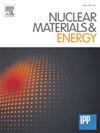Tritium release performance of neutron-irradiated core–shell Li2TiO3-Li4SiO4 pebbles
IF 2.7
2区 物理与天体物理
Q1 NUCLEAR SCIENCE & TECHNOLOGY
引用次数: 0
Abstract
To enhance the mechanical strength of Li4SiO4 and reduce its sensitivity to carbon dioxide and water, advanced tritium breeder core–shell Li2TiO3-Li4SiO4 was designed and fabricated by graphite bed method. The 1:1 phase ratio between Li2TiO3 and Li4SiO4 was confirmed by X-ray diffraction (XRD) and Rietveld refinement. Scanning electron microscopy (SEM) revealed that submicron-sized Li2TiO3 grains aggregated at the grain boundaries of Li4SiO4. Micro-computed tomography (Micro-CT) distinctly illustrated the shell-structure and the three-dimensional distribution of internal pores, aligning with the original design requirements and expectations. Neutron irradiation and out-of-pile tritium release experiments were conducted to evaluate the tritium release performance. Temperature-programmed desorption tritium release spectra exhibited two distinct release peaks, occurring at approximately 312 and 478 °C. The corresponding desorption activation energies were calculated using varying heating rates, yielding values of 0.63 eV and 1.64 eV, respectively. Isothermal desorption experiments indicated that complete release of residual tritium can be achieved at temperatures exceeding 400 °C. The tritium release rate-controlling process was found to be primarily diffusion of tritium through the crystal, with an effective diffusivity of 3.73 × 10-6exp(−1.35 eV/kT) m2/s.
中子辐照核壳型Li2TiO3-Li4SiO4卵石氚释放性能
为了提高Li4SiO4的机械强度,降低其对二氧化碳和水的敏感性,采用石墨床法制备了先进的氚增殖材料Li2TiO3-Li4SiO4。通过x射线衍射(XRD)和Rietveld细化证实了Li2TiO3和Li4SiO4的1:1相比。扫描电镜(SEM)显示,亚微米大小的Li2TiO3晶粒聚集在Li4SiO4晶界处。微计算机断层扫描(Micro-CT)清晰地显示了壳体结构和内部孔隙的三维分布,符合最初的设计要求和期望。通过中子辐照和堆外氚释放实验对氚释放性能进行了评价。程序升温解吸氚释放谱显示出两个明显的释放峰,分别发生在312°C和478°C左右。采用不同的升温速率计算了相应的解吸活化能,产率分别为0.63 eV和1.64 eV。等温解吸实验表明,在超过400℃的温度下,残余氚可以完全释放。氚的释放速率控制过程主要是氚在晶体中的扩散,有效扩散系数为3.73 × 10-6exp(−1.35 eV/kT) m2/s。
本文章由计算机程序翻译,如有差异,请以英文原文为准。
求助全文
约1分钟内获得全文
求助全文
来源期刊

Nuclear Materials and Energy
Materials Science-Materials Science (miscellaneous)
CiteScore
3.70
自引率
15.40%
发文量
175
审稿时长
20 weeks
期刊介绍:
The open-access journal Nuclear Materials and Energy is devoted to the growing field of research for material application in the production of nuclear energy. Nuclear Materials and Energy publishes original research articles of up to 6 pages in length.
 求助内容:
求助内容: 应助结果提醒方式:
应助结果提醒方式:


